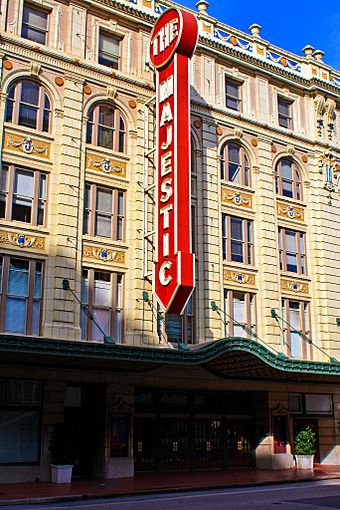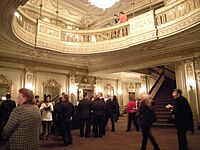Majestic Theatre (Dallas) facts for kids

Majestic Theatre
|
|
| Address | 1925 Elm St. Dallas, Texas United States |
|---|---|
| Coordinates | 32°47′1″N 96°47′40″W / 32.78361°N 96.79444°W |
| Owner | City of Dallas Office of Arts and Culture |
| Operator | City of Dallas Office of Arts and Culture |
| Type | Theatre |
| Capacity | 1,704 |
| Acreage | less than one acre |
| Screens | 1 |
| Current use | Performing Arts Center |
| Construction | |
| Built | 1921 |
| Opened | April 11, 1921 |
| Years active | 1921-1973, 1983-present |
| Architect | John Eberson |
|
Majestic Theatre
|
|
|
U.S. Historic district
Contributing property |
|
| Lua error in Module:Location_map at line 420: attempt to index field 'wikibase' (a nil value). | |
| Architectural style | Renaissance Revival |
| Part of | Dallas Downtown Historic District (ID04000894) |
| NRHP reference No. | 77001437 |
| Significant dates | |
| Added to NRHP | November 14, 1977 |
| Designated CP | August 11, 2006 |
The Majestic Theatre is a special place in Downtown Dallas, Texas. It's a theater where people go to watch live shows and performances. This historic building is the last one left from "Theater Row." That was a famous street in Dallas full of entertainment venues. The Majestic Theatre is also recognized as a special Dallas Landmark. It is listed on the National Register of Historic Places.
Contents
History of the Majestic Theatre
The Majestic Theatre was built in 1920. A famous architect named John Eberson designed it. It was meant to be the main theater for the Interstate Amusement Company. This company owned many "vaudeville" theaters. Vaudeville shows were popular back then. They had many different acts like singers, dancers, comedians, and magicians.
The theater opened on April 11, 1921. It cost $2 million to build, which was a lot of money at the time! It could seat 2,800 people. The new Majestic Theatre replaced an older one that had burned down.
Inside the Majestic Theatre
The inside of the theater was very fancy. It had a beautiful design called Renaissance Revival. The lobby had a stunning black-and-white marble floor. There were also two grand marble staircases. You could see fancy columns, detailed carvings, and sparkling crystal chandeliers. An old-fashioned cage elevator took people to the two balconies.
The main show area was amazing. The ceiling looked like a sky with floating clouds. It even had twinkling stars that moved! The seats were made of woven cane. A large orchestra pit was in front of the stage. Backstage, there were dressing rooms and space for scenery. A special theater organ was also installed.
Theater Row and Famous Performers
The Majestic was the grandest theater on Dallas's "Theatre Row." This street had many other theaters like the Melba, Tower, and Palace. But over time, all the other theaters were torn down. Only the Majestic Theatre remains today.
Many famous people performed at the Majestic. Magicians like Houdini and stars like Mae West and Bob Hope appeared during the vaudeville days. Later, movies were also shown. The theater hosted movie premieres with stars like Jimmy Stewart and John Wayne. Big music bands, including Cab Calloway and Duke Ellington, also played there.
In 1932, the Majestic Theatre started showing only movies. It was known for showing action films with actors like Humphrey Bogart. The theater closed on July 16, 1973, after showing the movie “Live and Let Die”.
Rebirth of the Majestic Theatre
In 1976, the Hoblitzelle Foundation gave the Majestic Theatre to the City of Dallas. The city decided to restore it. They wanted it to become a performing arts center again.
The outside of the building was repaired first. Then, the inside was carefully restored. Workers fixed and repainted the beautiful columns and decorations. They even put new 23K gold leaf on the fancy details. New seats were put in, but the number of seats was reduced. This made space for a bigger orchestra pit. It also allowed for new sound and lighting systems. The stage was made better for dance shows.
In 1977, the Majestic Theatre became the first building in Dallas to be listed on the National Register of Historic Places. This means it's a very important historical site.
The theater reopened on January 28, 1983. Today, the Majestic Theatre is a busy place. It hosts many different events. You can see musical shows, plays, dance performances, and concerts there.
Majestic Theatre in Pop Culture
- A famous writer named Horton Foote worked at the theater. He was an usher there in 1932-1933 when he was 16 years old. He wrote screenplays for movies like To Kill a Mockingbird.
- After it closed in 1973, the theater was used to film parts of the movie Phantom of the Paradise (1974).
- On May 26, 1991, the children's character Barney and the Backyard Gang performed a concert here. It was later released as a video called Barney in Concert.
- Psalty the Singing Songbook also filmed his "Funtastic Praise Party" special at the theater in 1992.
See also



